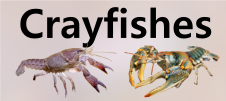







Loading profile. Please wait . . .
Cambarus scotti Hobbs, 1981
Chattooga River Crayfish




Federal Protection: No US federal protection
State Protection: Threatened
Global Rank: G3
State Rank: S2
Element Locations Tracked in Biotics: Yes
SWAP 2015 Species of Greatest Conservation Need (SGCN): Yes
SWAP 2025 Species of Greatest Conservation Need (SGCN): Yes
2025 SGCN Priority Tier: High Conservation Concern
Element Occurrences (EOs) in Georgia: 15
Habitat Summary for element in Georgia: rocky riffles in streams with moderate to swift current
The overall color of the Chattooga River Crayfish is tannish to brown, although the margins of the rostrum and various tubercles are bright reddish. The claws are a dull greenish and there are two rows of tubercles on the mesial margin of the palm. The areola is wide and nearly parallel sided; there is one sharp cervical spine on each side of the carapace. The rostrum is fairly long and tapers gradually to a point. This species reaches a maximum total body length of about 90 mm (3.5 in).
This species has been collected with the Variable Crayfish (Cambarus latimanus) and the Ambiguous Crayfish (Cambarus striatus). Both of these species have a much narrower areola than the Chattooga River Crayfish and neither have sharp cervical spines (occasional cervical spines present on juvenile Variable Crayfish).
The Chattooga River Crayfish is usually collected from beneath rocks or debris in flowing areas with sluggish to moderate flow (Kilburn et al. 2014).
No studies of the Chattooga River Crayfish are known. Crayfishes are considered opportunistic omnivores and are likely to feed on live and decaying vegetation, aquatic insect larvae, small fishes, and dead animal matter.
Stream dwelling crayfishes typically hide during the day and come out at night to feed. Reproduction usually occurs during the spring and fall, but males in reproductive condition may be found at any time during the year. When female crayfish are ready to lay eggs, they usually find a secure hiding place and hence are rarely encountered. When the eggs are released, the female attaches them to her swimmerets and is said to be "in berry." Upon hatching, the juvenile crayfish are attached to the mother by a thread. After the juveniles molt for the second time, they are free of the mother, but stay close and will hold on to her for some time. Eventually they move off on their own. Crayfishes molt 6 or 7 times during their first year of life and most are probably able to reproduce by the end of that year. They molt once or twice a year for the remainder of their lives and live about 3 years. Male Chattooga River Crayfish in reproductive condition have been collected from March to May and September to October and females carrying eggs were found in April. The number of eggs for four individuals ranged from 110 to 310, with egg diameters ranging from 2.1 to 2.3 mm. The smallest breeding male is about 49 mm (1.9 in) and the smallest female with eggs is about 62 mm (2.4 in) in length (Hobbs 1981).
Since this species is usually found in flowing water, it is most easily collected by holding a net perpendicular to the current downstream of a large rock, then lifting the rock and disturbing the substrate beneath it. If a crayfish is hiding underneath the rock, it will likely move into the net. Shocking downstream into a seine net with a backpack electroshocker or setting baited minnow traps overnight may also be effective.
The Chattooga River Crayfish is known from about 20 locations in the Chattooga River system in northwestern Georgia and northeastern Alabama. In Georgia it has been collected at about 14 sites in Walker and Chattooga counties within the Ridge and Valley physiographic province (Hobbs 1981, 1989; Kilburn et al. 2014).
The small range of this species and poor land use practices within that range are potential threats to the Chattooga River Crayfish. Heavy sedimentation resulting from poor development, land management, and agricultural practices may cover substrates and other daytime hiding places on which crayfishes rely to avoid predation. The introduction of non-native crayfishes is a threat to all native crayfishes.
| Threat 1 | Threat 2 | Threat 3 | |
|---|---|---|---|
| General Threat | Natural system modifications | Invasive & other problematic species, genes & diseases | Pollution |
| Specific Threat | Dams & water management/use | Invasive non-native/alien species/diseases | None |
This species considered to be stable in Georgia.
Conserving populations of the Chattooga River Crayfish will require general watershed level protection measures, including the protection of riparian zones, control of sediment and nutrient runoff from farms and construction sites, and limiting the amount of impervious cover (e.g., pavement) within occupied watersheds. Non-native crayfishes should never be used for bait. Instead, anglers should use crayfishes collected from the river system they will be fishing in and should never release unused bait crayfish back into Georgia waters.
Hobbs, H.H., Jr. 1981. The crayfishes of Georgia. Smithsonian Contributions to Zoology 318:1–549.
Hobbs, H.H., Jr. 1989. An illustrated checklist of the American crayfishes (Decapoda: Astacidae, Cambaridae, and Parastacidae). Smithsonian Contributions to Zoology 480:1–236.
Kilburn, S.L., C.A. Taylor, and G.A. Schuster. 2014. Conservation assessment and habitat notes for three rare Alabama crayfishes: Cambarus cracens, Cambarus scotti, and Cambarus unestami. Southeastern Naturalist 13:108–118.
Taylor, C.A., G.A. Schuster, J.E. Cooper, R.J. DiStefano, A.G. Eversole, P. Hamr, H.H. Hobbs III, H.W. Robison, C.E. Skelton, and R.F. Thoma. 2007. A reassessment of the conservation status of crayfishes of the United States and Canada after 10+ years of increased awareness. Fisheries 32:372–389.
Christopher E. Skelton
C. Skelton, 2008: original account
C. Skelton, January 2019: general update of account.